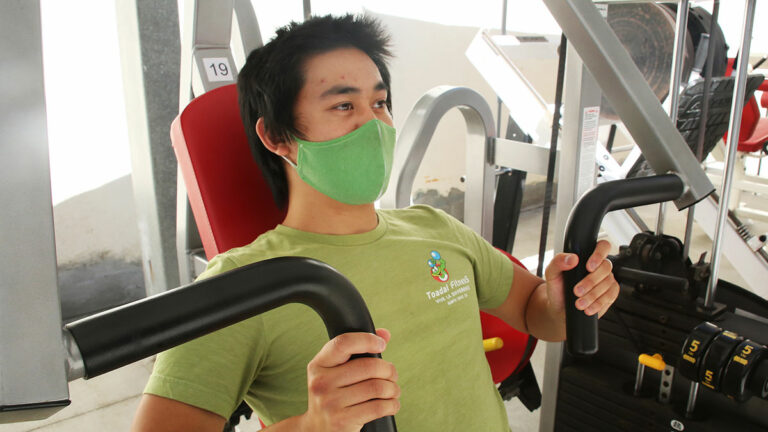Because many in-person events across Santa Cruz County have been canceled or postponed during the pandemic, Good Times is compiling a weekly list of virtual events hosted by local nonprofits, artists, fitness instructors and businesses. To submit your virtual event, send an email to ca******@go*******.sc.
ARTS AND MUSIC
THEN, NOW AND ONWARD: 115 YEARS OF THE SANTA CRUZ MUSEUM OF NATURAL HISTORY Celebrate 115 years of the Santa Cruz Museum of Natural History! Explore highlights of our history, the current state of the museum, and our plans for the future during this webinar event. We will hear from community members, dig into the archives, and our Executive Director Felicia B. Van Stolk will present the annual Laura Hecox Naturalist Award to Amity Sandage, environmental literacy coordinator for the Santa Cruz County Office of Education. Aug. 21, 6-7pm. Learn more at santacruzmuseum.org/then-now-and-onward.
CLASSES
BREASTFEEDING BASICS This is a virtual class that will help you learn the information you need for getting breastfeeding off to a good start. This one-session class will cover how to ensure a good milk supply, techniques for getting a good latch, how to know if your baby is getting enough, and ways you can avoid common problems. Recommended for mothers in mid-to-late pregnancy. Support person welcome. Please register for the PEP class session. Only after you have completed this process, the Zoom meeting information will be provided to you via email prior to your class. For further information, please call the Dominican Lactation Warm Line at 831-462-7862. Wednesday, Aug. 19, 6:30-8:30pm.
CHILDBIRTH EDUCATION WEEKEND EXPRESS CLASS This Saturday and Sunday virtual class is intended for expectant mothers and their labor support team. Focus will be on the birth process, including the stages of labor and when to go to the hospital. Non-pharmaceutical coping techniques for pain, including breath work, mindfulness practices, supportive touch and positions for labor and birth, along with standard hospital procedures, pain medication options, medical interventions, cesarean birth, postpartum recovery, newborn procedures and breastfeeding basics. In this class, we will actively practice positions and coping techniques for pain, so please be dressed for movement. Please register for the PEP class session. Only after you have completed this process, the Zoom meeting information will be provided to you via email prior to your class. Classes run 1-5:30pm: Aug. 22-23, Sept. 26-27, Oct, 24-25, Nov. 14-15, Dec. 19-20.
HOLISTIC STRATEGIES FOR YOUR IMMUNE SYSTEM Traditionally, fall and winter can be a challenge for your immune system, but it doesn’t need to be. If you get sick all the time or catch every cold that goes around, it would be worthwhile to assess your habits and environment and make some changes. Come learn some holistic strategies to boost your immunity. In this class you will learn about foods, herbs and other lifestyle choices and habits that will support your overall health. Come learn about new habits you can adopt to optimize your health. $15. Pre-registration required. Zoom link will be provided after you register. Call PEP at 831-457-7099.
SALSA SUELTA IN PLACE: Free weekly online session in Cuban-style Salsa Suelta for experienced beginners and up. Contact to get a Zoom link. Thursdays at 7pm. salsagente.com.
COMMUNITY
2020 BE THE DIFFERENCE AWARDS CALL FOR NOMINATIONS Friends, it is that time of year again! At the Volunteer Center of Santa Cruz County, we are excited to announce the call for nominations for the 2020 Be the Difference Awards. Each year we reach out, asking you to share your extraordinary stories of volunteers, businesses, and nonprofits who make our community a happier, healthier place to live through volunteerism. This year is no different. Despite all of the challenges we have faced, volunteerism has not faltered. We know without a doubt that volunteers uplift our community and often give hope when there is little. If ever there was a year to celebrate volunteers and the power of community connection, this is the year. This year, the Be the Difference Awards Celebration will go entirely online so that community members can participate safely from home. The Volunteer Center in partnership with their presenting sponsor Santa Cruz Community Credit Union, KION-CBS, and fellow sponsors will present a virtual lunchtime watch-party on Wednesday, Oct. 21. Learn more and nominate now through Aug. 21 at scvolunteercenter.org/events-2/be-the-difference-awards.
LUMA BOOK CLUB This is a time of seismic shift, and yet also one of opportunity. Luma Yoga is a community center operating on principles of inclusion, compassion, and, yes, reflection, but make no mistake—also of action. The first step in effective action is gaining knowledge. To this end, Luma is hosting a book club on the topic of racism and social justice issues. The reading groups will be held remotely (for now) over Zoom Thursday nights 7-8:15pm. The purpose of the groups is to learn the endless shapes oppression can take in the world, to recognize our own biases within ourselves, and to move from discomfort to action in support of Black and non-white POC. The groups will be facilitated by Steven Macramalla, a professor of psychology at SJSU. The Club will work on a 3- to 4-week cycle, reading one book per cycle, with several chapters covered each week. For more info visit lumayoga.com. Thursdays at 7pm.
TALES TO TAILS GOES VIRTUAL Beginning Aug. 10, SCPL’s early childhood literacy program, Virtual Tales to Tails, is moving to a new time slot: Mondays, 3:30-4:30pm. At the end of your school day, hop online and have fun reading at your own pace to an audience of therapy dogs, cats and other guest animals. Have math homework? Good news! Your furry audience would also love to learn how to count, add and subtract. Register online. Registrants receive reminders, links to the live program, and fun (educational) activities to complete and have showcased on future sessions Learn more at santacruzpl.libcal.com/event/6764938.
GROUPS
VIRTUAL YOUNG ADULT (18-30) TRANSGENDER SUPPORT GROUP A weekly peer support group for young adults aged 18-25 who identify as transgender, non-binary, genderqueer, agender, or any other non-cisgender identity. This is a social group where we meet and chat among ourselves, sharing our experiences and thoughts in a warm, welcoming setting. Our meetings will be held on Discord during the shelter-in-place order. For more info, contact Ezra Bowen at tr***@di*************.org.
LGBTQNBI+ SUPPORT GROUP FOR CORONAVIRUS STRESS This weekly LGBTQNBI+ support group is being offered to help us all deal with stress during the shelter-in-place situation that we are experiencing from the coronavirus. Feel free to bring your lunch and chat together to get support. This group is offered at no cost and will be facilitated by licensed therapists Shane Hill, Ph.D., and Melissa Bernstein, LMFT #52524. Learn how to join the Zoom support group at diversitycenter.org/community-calendar.
OUTDOOR
VIRTUAL ROCKIN’ POP-UP Join the Geology Gents, Gavin and Graham, for weekly conversations about rocks live on Facebook. Each week we’ll explore a different geologic topic, from Santa Cruz formations to tips for being a more effective rockhound. Graham Edwards and Gavin Piccione are PhD candidates in geochronology with the Department of Earth and Planetary Sciences at UCSC. Submit your questions ahead of time on Facebook or by emailing ev****@sa*************.org, or during the program live on Facebook. Feel free to include pictures of rocks you’d like identified! Pro-tip: the better the picture, the better the ID. Wednesdays at 3pm. Learn more at santacruzmuseum.org/upcoming-events.
NATURALIST NIGHT: SANTA CRUZ HABITATS AND HISTORY Santa Cruz Public Libraries and the Santa Cruz Museum of Natural History have partnered to bring you Naturalist Night! Join fellow nature enthusiasts for monthly explorations of the biodiversity of Santa Cruz County. Each month, Marisa Gomez from the Santa Cruz Museum of Natural History will share the stories of a specific Santa Cruz habitat as we develop our skills as naturalists. This series will feature a presentation as well as an interactive session. This program occurs monthly on the fourth Tuesday from 6-7 pm, with upcoming events Aug. 25 and Sept. 22. Registration is required for Zoom access link. Your registration confirmation email will have the Zoom link in it. Register online: santacruzpl.libcal.com/event/6857442.
BIRD BEHAVIORS Take a close look at behaviors of acorn woodpeckers, Steller’s jays, and Anna’s hummingbirds in the Sandhills. Learn about feeding behaviors, why they skip, hop, and jump, and how they protect themselves and their young. This interactive program will be broadcast as a Zoom webinar. Registration is required. To register, visit tinyurl.com/SantaCruzJuniorRangers. Free event. Saturday, Aug. 22, 10am. California State Parks in Santa Cruz County are offering virtual junior ranger programs for children ages 7-12 during the Covid-19 pandemic. These fun, free Zoom webinars are scheduled Friday through Monday at 10am each week in August. Children receive a digital stamp for each program they attend; after receiving a certain number of stamps, they can earn prizes!
MARVELOUS MURRELETS Learn about a day in the life of the marbled murrelet, the challenges they face, and how you can help protect this marvelous bird! This interactive program will be broadcast as a Zoom webinar. Registration is required. To register, visit tinyurl.com/SantaCruzJuniorRangers. Free event. Sunday, Aug. 23, 10am. California State Parks in Santa Cruz County are offering virtual junior ranger programs for children ages 7-12 during the Covid-19 pandemic. These fun, free Zoom webinars are scheduled Friday through Monday at 10am each week in August. Children receive a digital stamp for each program they attend; after receiving a certain number of stamps, they can earn prizes!


























